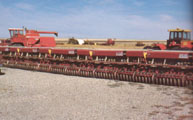|
● History
● The
Canada-US Free Trade Agreement
● Natural
Resources
● Agriculture
● Manufacturing
Industries
● Service
Industries
● Canada's
Place in the World Economy
Agriculture
 Eighty—eight
per cent of the Canadian landmass
is unsuitable for farming, and throughout the country, soil is poor,
the growing season is short and the climate is harsh. Most farming
takes place in a narrow band along the southern border of the country,
within 500 kilometres of the United States. And wheat farming, for
example, on the Canadian prairies, is made even more difficult because
the products are far away from the metropolitan
markets, so transportation costs make farm products even more expensive. Eighty—eight
per cent of the Canadian landmass
is unsuitable for farming, and throughout the country, soil is poor,
the growing season is short and the climate is harsh. Most farming
takes place in a narrow band along the southern border of the country,
within 500 kilometres of the United States. And wheat farming, for
example, on the Canadian prairies, is made even more difficult because
the products are far away from the metropolitan
markets, so transportation costs make farm products even more expensive.
 Despite
the difficulties, agriculture remains important to the Canadian
economy. The prairie provinces specialize in wheat and cereals
production, feedstock and cattle: farms tend to be very large.
This region accounts for Despite
the difficulties, agriculture remains important to the Canadian
economy. The prairie provinces specialize in wheat and cereals
production, feedstock and cattle: farms tend to be very large.
This region accounts for
|
|
|
Big Farms in the
Prairie Area
|
 |
 |
| Big Fields and Big Operations
Mean Enormous Investment in Equipment for Prairie Farmers. |
about 51 per cent of Canada's agricultural
output. Transportation costs are partially alleviated by
a federal government subsidy policy introduced in World War
II, which, for example, means that feeds can be shipped to
other provinces cheaply. Such policies have allowed regions to specialize
in the production of particular farm products.
 In
1981, more than three—quarters of Canada's dairy
farms and two-thirds of hog
farms were located in the eastern provinces of Quebec and Ontario:
the animals are fed by prairie grains brought in by train. These
farms are much smaller—about one-fifth the size on average—than
the sprawling
prairie ranches. In
1981, more than three—quarters of Canada's dairy
farms and two-thirds of hog
farms were located in the eastern provinces of Quebec and Ontario:
the animals are fed by prairie grains brought in by train. These
farms are much smaller—about one-fifth the size on average—than
the sprawling
prairie ranches.
 New
Brunswick and Prince Edward also have large poultry sectors,
and also specialize in potato production. Fruits and vegetables
can only be grown in areas with comparatively mild climates, and
so are very local in nature: British Columbia, for example, has
a lot of orchards, and the weather is mild enough to allow
for the development of a local wine industry. New
Brunswick and Prince Edward also have large poultry sectors,
and also specialize in potato production. Fruits and vegetables
can only be grown in areas with comparatively mild climates, and
so are very local in nature: British Columbia, for example, has
a lot of orchards, and the weather is mild enough to allow
for the development of a local wine industry.
|
|
|
|
Many of the Wineries
in this Area are Renown for their Award Winning Wines
|
British Columbia
Wine
|
 In
the past, agricultural exports have been very important to the Canadian
economy: before World War I, 50 per cent of Canada's exports were
agricultural; this fell to 40 per cent after World War II. But in
recent years there has been a dramatic drop, and now they comprise
less than 10 per cent of Canada's total exports. Furthermore, it
has become cheaper in many cases to import foodstuffs rather than
to produce such items domestically. For example, it makes more geographical
sense for Easterners to buy their vegetables from neighbouring American
states rather than shipping similar products from western Canada.
The conclusion of the Free Trade Agreement also displaced inefficient
Canadian farmers, who used to rely on government subsidies to remain
productive. In
the past, agricultural exports have been very important to the Canadian
economy: before World War I, 50 per cent of Canada's exports were
agricultural; this fell to 40 per cent after World War II. But in
recent years there has been a dramatic drop, and now they comprise
less than 10 per cent of Canada's total exports. Furthermore, it
has become cheaper in many cases to import foodstuffs rather than
to produce such items domestically. For example, it makes more geographical
sense for Easterners to buy their vegetables from neighbouring American
states rather than shipping similar products from western Canada.
The conclusion of the Free Trade Agreement also displaced inefficient
Canadian farmers, who used to rely on government subsidies to remain
productive.
Previous Page Next
Page
|

